
Beautiful Wild Cats in Mexico
Mexico is home to an astonishing diversity of wild cats, each playing a crucial role in the region's delicate ecosystem. Here in the Yucatán Peninsula, amidst the bustling resorts and vibrant beaches, these elusive felines continue to roam, a testament to the resilience of nature.
Jaguar: The Majestic Guardian of the Jungle
The undisputed king of the Yucatán Peninsula's jungles, the jaguar (Panthera onca) is a breathtaking symbol of power and grace. With its muscular build, striking rosette patterns, and piercing amber eyes, this apex predator commands respect and awe. Revered by the ancient Maya as a god-like figure, the jaguar once held dominion over vast swaths of the Americas, from the southwestern United States to the tip of Argentina.
Today, however, the jaguar's territory has shrunk significantly due to habitat loss, poaching, and human encroachment. In the Yucatán Peninsula, sightings of these magnificent creatures have become increasingly rare. Their elusive nature and dwindling numbers make each encounter a precious glimpse into a world where the wild still reigns.
Despite their diminished range, jaguars continue to play a vital role in the ecosystem. As apex predators, they regulate populations of herbivores, maintaining the delicate balance of the food web. Their presence is an indicator of a healthy ecosystem, a reminder that the survival of these majestic creatures depends on our efforts to protect their habitats and coexist with them peacefully.
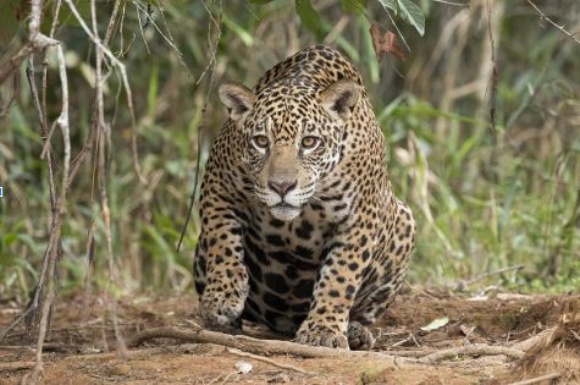
Though they may be hidden from view, the spirit of the jaguar lives on in the Mayan culture and the wild heart of the Yucatán. Their presence serves as a constant reminder of the importance of conservation and our responsibility to protect these magnificent creatures and their fragile environment.
Puma: The Elusive Phantom of the Yucatán Peninsula
Known by many names – mountain lion, cougar, or even catamount – the puma (Puma concolor) is a true testament to adaptability. Its range stretches from the snowy peaks of the Canadian Rockies to the steamy jungles of South America, showcasing its ability to thrive in diverse habitats. Here in the Yucatán Peninsula, it reigns as an apex predator, maintaining the delicate balance of the ecosystem.
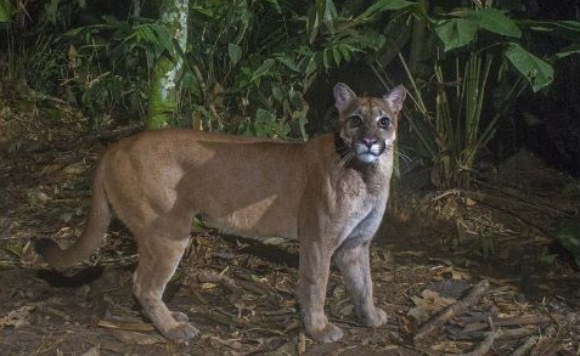
The puma is a solitary creature, preferring to roam vast territories alone. Its presence in the Yucatán is often only hinted at, a fleeting shadow disappearing into the dense foliage or a set of distinctive paw prints etched in the sandy soil. Despite its elusive nature, the puma plays a vital role in maintaining the health of the ecosystem by controlling populations of deer and other prey animals.
This stealthy hunter possesses incredible strength, agility, and a powerful bite. Its adaptability extends to its diet, which includes everything from rodents to large mammals like deer. The puma's ability to thrive in various environments, combined with its cunning hunting skills, have made it one of the most successful predators in the Americas.
While encounters with pumas are rare, their presence in the Yucatán is a constant reminder of the wild beauty that coexists alongside human development. As we continue to explore and enjoy the natural wonders of this region, let's remember to respect these magnificent creatures and their vital role in the delicate ecosystem.
Jaguarundi: The Daytime Prowler
The jaguarundi (Herpailurus yagouaroundi) defies many of the typical feline stereotypes. With its elongated body, short legs, rounded ears, and an exceptionally long tail that can account for nearly half its total length, this unique cat has a physique more reminiscent of a weasel or otter than a typical house cat. However, this unconventional form is perfectly suited to its lifestyle and habitat.
Nature has painted the jaguarundi in two distinct color morphs: a rich, reddish-brown phase and a more subdued grayish phase. Both variations allow this stealthy hunter to blend seamlessly into the diverse landscapes of the Yucatán Peninsula, from the dense underbrush of tropical forests to the open scrublands.
While most cats prefer the cloak of darkness for their hunting expeditions, the jaguarundi boldly embraces daylight as its prime time to shine. This diurnal hunter is a tireless pursuer, relying on its exceptional agility, lightning-fast reflexes, and powerful legs to chase down prey. Small mammals like rodents, birds, lizards, and even fish become the jaguarundi's targets, as it fearlessly navigates the tangled undergrowth in pursuit of its next meal.
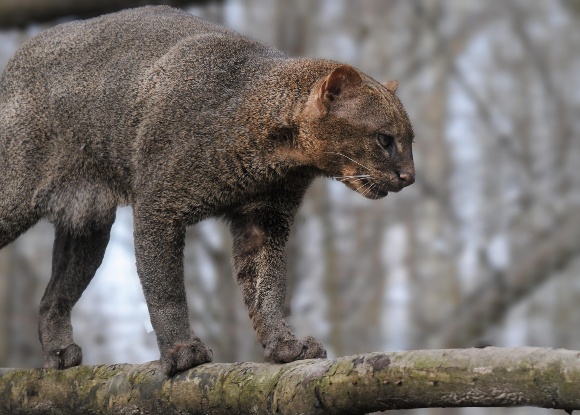
Imagine yourself hiking through the Mayan jungle. A flash of reddish-brown or gray streaks past you, a blur of motion barely glimpsed before it disappears into the dense vegetation. If you're fortunate enough to witness this spectacle, you've just encountered the elusive jaguarundi, a true daredevil of the Yucatán's wild heart.
Margay: The Phantom of the Canopy
With its oversized paws, captivating emerald eyes, and a tail as long as its body, the margay (Leopardus wiedii) is a mesmerizing marvel of evolution perfectly adapted to life in the treetops.
A true arboreal acrobat, the margay possesses an extraordinary ability to rotate its hind legs a full 180 degrees, allowing it to effortlessly navigate the dense branches of the Yucatán jungle. Picture this graceful feline hanging upside down from a limb, using its prehensile tail as a fifth limb for balance as it stalks unsuspecting prey.
The margay's stunning coat, a rich tapestry of dark rosettes and spots against a golden backdrop, provides impeccable camouflage amidst the dappled sunlight of the rainforest. While its large eyes may seem almost otherworldly, they serve a crucial purpose: enhancing its vision in low-light conditions. This adaptation allows the margay to become a phantom of the night, silently hunting birds, squirrels, and even small monkeys high in the canopy.
Although the margay is the smallest of the Neotropical spotted cats, its diminutive size doesn't diminish its hunting prowess. Its razor-sharp claws, powerful muscles, and lightning-fast reflexes make it a formidable predator in the arboreal realm. It's a master of stealth and surprise, capable of leaping incredible distances to pounce on its unsuspecting prey.
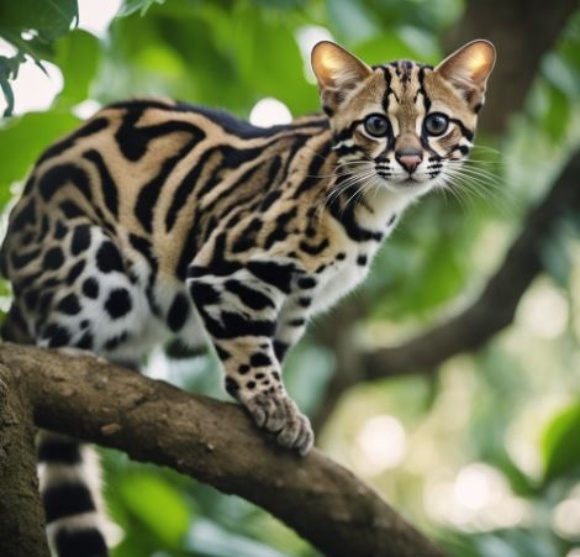
The margay's elusive nature and nocturnal habits make it a rare and precious sight. If you're lucky enough to catch a glimpse of this arboreal acrobat, consider yourself privileged to have witnessed a true marvel of the Yucatán jungle.
Ocelot: The Spotted Nocturnal Hunter
The ocelot (Leopardus pardalis), a medium-sized wild cat with an undeniable charisma, is perhaps the most recognizable of the Yucatán Peninsula's elusive feline inhabitants. Its mesmerizing fur, a canvas of intricate rosettes and bold stripes, is not just a fashion statement—it's a masterpiece of camouflage, allowing it to melt seamlessly into the dappled sunlight that dances through the jungle canopy.
Though often associated with the forest floor, the ocelot is a surprisingly adept climber, utilizing its strong claws and powerful limbs to ascend trees with ease. This versatility serves a dual purpose: aiding in hunting arboreal prey like monkeys and birds, and providing refuge from potential predators on the ground.
The ocelot's true domain is the night. Under the cloak of darkness, this skilled hunter emerges, its large, reflective eyes piercing the gloom as it stalks its unsuspecting prey. Its superior senses of sight and hearing, finely tuned for nocturnal life, guide it through the tangled undergrowth as it ambushes rodents, rabbits, birds, and reptiles with remarkable agility and precision.
While encounters with the ocelot are rare due to its nocturnal nature and preference for seclusion, its presence in the Yucatán is a testament to the region's rich biodiversity. The ocelot's unique beauty and ecological significance make it a true jewel of the Mayan jungle, a symbol of the wild heart that beats beneath the surface of this tropical paradise.
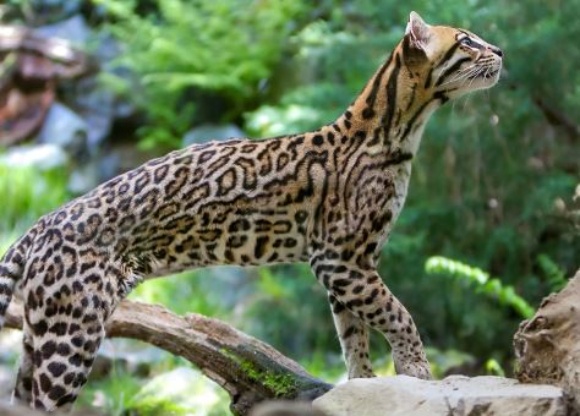
Guardians of the Yucatán: Sandos Supports Wild Cat Conservation
Each glimpse of this elusive creature serves as a reminder of the delicate balance that exists between nature and human development, urging us to cherish and protect the wild wonders that still thrive in our midst.
While encounters with these elusive felines may be rare, the mere possibility of spotting a jaguar, puma, jaguarundi, margay, or ocelot adds an extra layer of excitement to any Yucatán adventure. Their presence serves as a constant reminder of the region's wild heart, urging us to tread lightly and appreciate the delicate balance of nature.
At Sandos Hotels & Resorts, we understand the importance of preserving this delicate balance. We actively support conservation efforts in the region and strive to minimize our impact on the environment. We believe that responsible tourism can play a vital role in protecting these magnificent creatures and the ecosystems they inhabit.
By choosing to stay at a Sandos resort, you're not just enjoying a luxurious vacation – you're also contributing to the conservation of Mexico's rich biodiversity. So, next time you venture into the jungles or beaches of the Yucatán, keep your eyes peeled and your ears open – you never know what secrets the shadows might reveal. And remember, every step you take to protect our planet helps ensure that these incredible wild cats will continue to roam free for generations to come.

